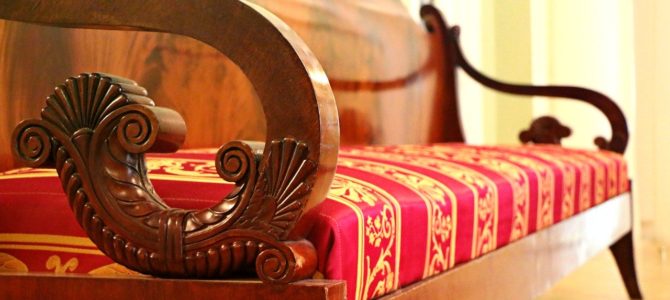
I spent most of my undergraduate years sleeping on the floor. It saved space, which saved money because my roommates and I stuffed our lodgings with more people than we were probably supposed to have. The rent was very cheap.
After graduating, I loaded up my car and drove across the country for a new job. Before marrying my lovely wife a few years later, I moved from the East Coast to the Midwest, again hauling everything in my car.
In short, I didn’t think much about furnishing a home until I was married. As a child, that was my parents’ task. As a single young man in school or working, I got by with whatever was cheap or could be scrounged; the rooms I lived in were just places to stay, rather than home. When I was an undergraduate, I lived like an undergraduate.
Marriage was time for the accoutrements of adulthood to replace those of youth, to grow up and think about what we wanted in our home for the rest of our lives. Over the years we have slowly furnished our home with things that will last. It is a work on progress (the wall of cheap bookshelves has only recently been replaced by shelves made from real wood), but matters are much improved from when I slept on the floor and kept clothing in plastic tubs.
My youthful shabbiness did not arise from asceticism; I was just a student who did not care much about my living quarters. This was fine at the time, but I knew that it was not a model for the whole of life.
Conservatives proclaim the important of the Permanent Things. We should also, in a throwaway culture of plastic and particle board, value permanent things. In an age of utility and ugliness, we should value beauty, including in our homes. For example, getting a real desk was a functional improvement over the plastic folding table I used to work at, but I also enjoy the aesthetics of quality hardwood, well-crafted and beautifully finished.
My home will never look like a showroom. It is in too much use by people and dogs, and our current residence limits elegance—our living room is also my library, office, and music room (although at least the double bass looks classy). Still, we try furnish it for the long term, rather than disposable utility or fashion.
We want things that can be passed down to future generations. For example, my wife and I are the fourth generation of her family to use our current dining set. Although it is now a bit battered and needs some repair and a refinish, it has held up well against decades of use, as quality furniture should. We would like to similarly pass things on to those who come after us.
Over time, such things can acquire meaning. This may be sentimental, but it is not nonsense. The permanent things in our lives can serve as talismans and reminders of the Permanent Things. They provide a physical connection to those who came before us, to our own past, and, if preserved and passed down, to those who will succeed us. Their longevity reminds us that we are mortal pilgrims on this earth, yet also provides us comfort and familiarity while we are here. The underside of our table has the original sales markings from a century ago and my wife’s crayon signature from when she was five years old.
We are embodied beings, so the intergenerational connections these physical items provide are important. Some things are created with such significance. The two best and most meaningful pieces of furniture my wife and I have are those that my father, a skilled amateur woodworker, made for us to commemorate our wedding and my doctorate. These, an inlaid cabinet and a campaign-style bookcase, are beautiful, functional, and personal.


Of course, much of our stuff has not been passed down through generations of family, or handcrafted for us by a family artisan. My woodworking skills suffice for basic functionality, but do not extend beyond a bookcase or speaker cabinet. And while we have bought a few nice things new, we do not have the funds to fully furnish our home with new hardwood furniture from American manufacturers. Fortunately, there is a thriving market for good used furniture.
This is a countercultural option; we are encouraged to buy new, disposable products, rather than engage in the practical recycling that is restoring and using older stuff. But the conservation and use of something good is the literal practice of conservatism.
Although what is bought secondhand will initially lack the emotional connection of old family pieces, I hope that some of what we buy will become heirlooms for future generations. Perhaps a grandchild will one day write at the beautiful desk I picked up used. Good woodworking lasts for decades, even centuries, and those who receive and use something thus passed down will not care whether the family got it new or a few years old.
It helps that the internet has made it easier to find good used furniture. To be sure, it still takes time to find the right item at the right price, but it is much more convenient than it used to be. Trawling thrift stores and garage, yard, or estate sales hoping they have, say, a good coffee table has been superseded by browsing sites such as eBay and Craigslist while drinking coffee at home. Of course, the work of identifying good craftsmanship, and then moving, cleaning, and restoring it remains.
This approach requires patience; it is budget-friendly while still valuing quality, but it will not immediately remake a domicile. For months, my beautiful desk sat next to the cheapest bookshelves available, and children, pets, and the burdens and business of life will keep most of us far from having things look perfect.
Still, we should value quality and craftsmanship, even if we can sometimes only afford it to a limited degree or secondhand, and restoring and reusing some things will also make it easier to afford quality, American-made products when buying new. Instead of consuming disposable products from our nation’s rivals, we can create, preserve and restore things that endure. Consumption is about ourselves and the present, whereas the physical handing-down of family possessions connects generations even while it reminds us of our mortality.









